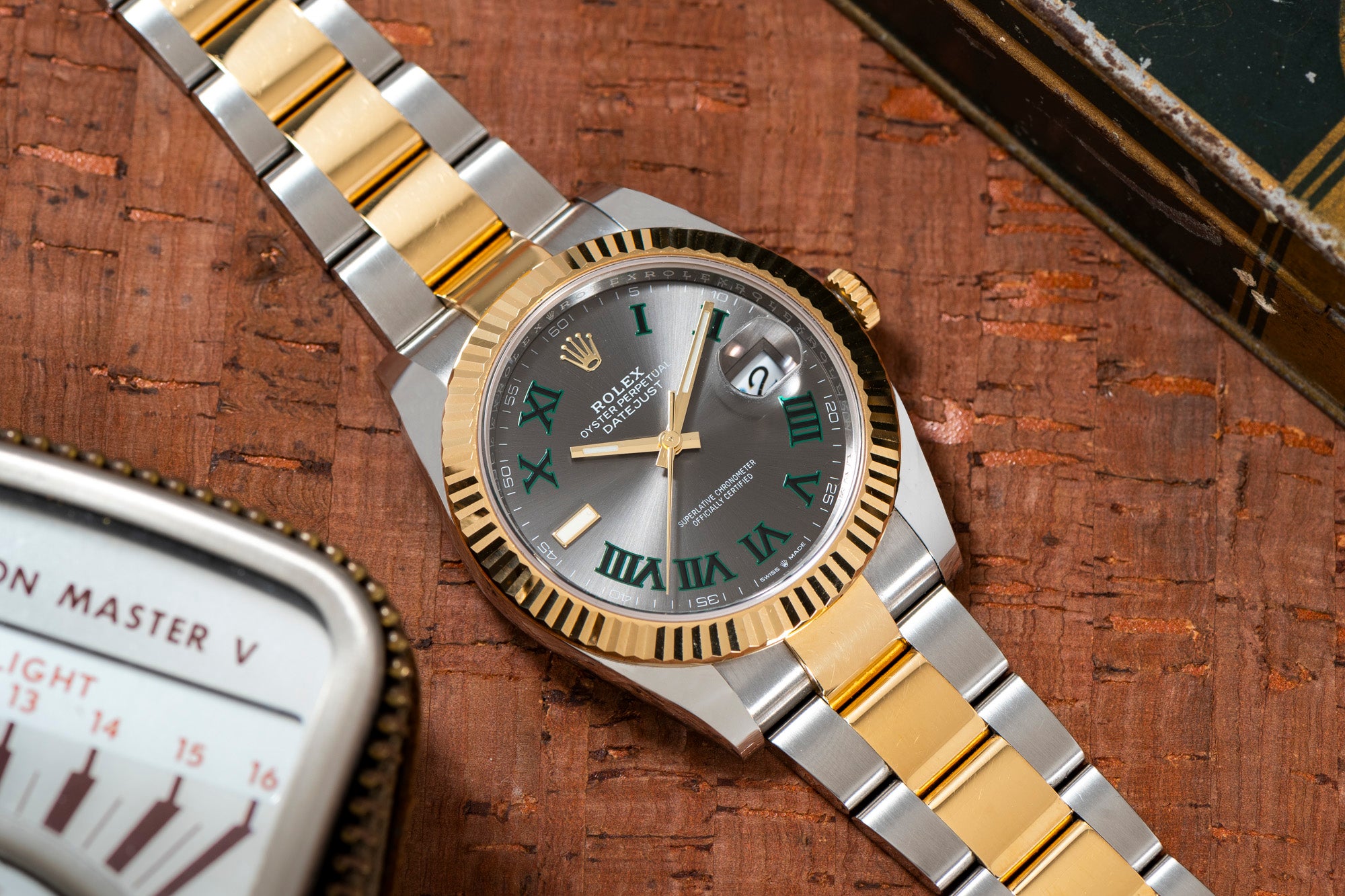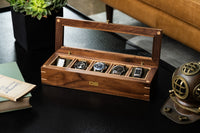The word "iconic" is probably one of the most overused in the luxury watch industry.
It seems that everyone is rushing to brand nearly every watch as an "icon" before it's even been released. This label, however, should really only be tacked on to a small subset of truly legendary timepieces that define a category, mechanical achievement, or other groundbreaking innovation.
While not every watch can achieve this lauded status, the Rolex Datejust is unequivocally an icon, and we give our stamp of approval to anyone who refers to it as such. The Datejust redefined the concept of an everyday, versatile timepiece that can be placed on the wrist and left there forever. And while the Datejust as a collection has retained its status a the definitive benchmark for wristwatches, it has evolved over the years, adapting its DNA to suit modern interests and audiences. Today we'll navigate through what we consider the milestone references, and hopefully, you'll gain an understanding of just what makes the Datejust a real icon of the watch industry.
NOTE: The price ranges we quoted are accurate as of publish, but markets are of course subject to change. Check our listings frequently for examples of current pricing.
Significant References
Reference 4467 (1945)

Rolex Datejust "Ovettone" - (Image by PHILLIPS )
Introduced in 1945 to commemorate the 40th anniversary of the Rolex brand, the solid yellow gold Datejust was the very first automatically wound wristwatch to feature a date function. The original Datejust laid the groundwork for the subsequent references, establishing many of the defining characteristics that remain present to this day. Most notably, the 4467 incorporated a lightly fluted bezel and was the first piece to feature the "Jubilee" bracelet. ("Jubilee" typically refers to a notable anniversary of an event. In this case, the Jubilee bracelet was named in recognition of Rolex's 40th anniversary, and the name stuck.) The final key element of the engineering on the 4467 was its utilization of the Oyster case, providing waterproofing via a screw-down crown.
1950’s References

Rolex Datejust 18k
As the '40s rolled into the '50s, the Datejust saw a movement upgrade which allowed for a slimmer profile. These newer models had flat casebacks due to the use of more compact movements, replacing the 'bubble back' found on the earliest models. References such as the 6604 and 6605, from the 1950s are incredibly rare due to their relatively small production numbers and older age, and examples in good condition command a pretty penny these days. Most of these models featured the updated 1065 movement, and models made after 1957 read "Datejust" on the dial for the first time.
16XX References (1960s-1970s)

Rolex Datejust 'Linen'
References such as the 1600, 1601 and 1603, provided hacking seconds for the first time, are possibly the most accessible and well known segment of the Datejust family. Fitted with modernized Calibres 1560 or 1570, these references began to incorporate some of the luxuries of modern watchmaking, with more robust movement construction.
Where's the Reference 1601 features a fluted bezel, while the 1603 has the more casual engine-turned variation. These references are truly the bread and butter of the vintage Datejust market; abounding in great numbers and relatively affordable, they're one of the best entry points to Rolex, and to vintage watches in general. An exciting scholarly pursuit for some — not an obsession, we swear — is collecting special dial variations of these references. Most notably, textured linen dials, or a personal favorite of ours, the printed 'Buckley' dial, are worth pursuing.
60XX References (Late 1970s-1980s)

Rolex Datejust Quickset
By the late '70s, Rolex’s Datejust entered a more contemporary stage, adding elements of robust, modern construction while maintaining the fundamental vintage proportions of the previous references. Rolex once again updated the movement to the Calibre 3035, which notably provided a quickset date for the first time. Bracelets became much more substantial (although they still had hollow end-links), and the overall weight of the Datejust increased as a result. Nonetheless, the case profile was still slim and versatile. The References 16014, 16013, 16000, and 16030 all stem from this era, and many stellar examples are readily available today.

Rolex Datejust
Oysterquartz Reference 17000 (1970s-2000s)

Rolex Datejust Oysterquartz
With the 'Quartz Crisis' threatening the stability of the luxury watch market, Rolex responded with the release of a quartz Datejust with an integrated bracelet called the Oysterquartz — a sub-collection that has since become quite desirable because of its obscurity and limited production numbers. The first Oysterquartz was introduced in 1977 with the Reference 17000 and outfitted with the quartz Calibre 5035. By 2002, the Oysterquarz was abandoned, but many collectors remained interested in the angular case profile of these obscure models. Notably, the Calibre 5035 is incredibly elaborately decorated for a quartz movement — were else can one find a quartz movement with Côtes de Genève?!
162XX References (1990s-Early 2000s)

Rolex Datejust
The '90s references mostly built upon the previous models, adding slight refinements such as sapphire crystals and an updated Calibre 3135 movement. Beyond these marginal changes, the pieces remained mostly the same. These references include the 16200, 16220, 16233, 16234, and 16238. (Note: The engine-turned bezels that first appeared in the Reference 1603 also disappeared from the catalog around this time, leaving either fluted or smooth bezels as options.)
Six-Digit Datejusts (2000 to 2009)

Rolex Datejust 'Roulette'
With the arrival of the six-digit references, the entire Datejust case was redesigned, resulting in some of the most noticeable updates to the model family since the '60s references. The newer models were significantly stronger in appearance, with thicker lugs, slightly sportier and thicker cases, solid end-links, and an updated bracelet clasp. These watches feel very consistent with the most recent releases, and certainly have a contemporary feel on the wrist. If you want the aesthetic of a modern Datejust but need a slight break on the price, this is the era to consider; the tradeoff is a slightly outdated movement by contemporary standards, but all the handsome aesthetics one could ask for.
The Modern Datejust

Rolex Dajust II 'Wimbledon'
Today, the Datejust is offered for men in both 41mm and 36mm variants with updated Calibre 3235 movements. These references maintain the same sportier design presence of the previous generation but with a slightly larger bezel than earlier models. There are dozens of configurations available, from stainless steel to two-tone; endless dial colors; diamond-set bezels, and more. The Datejust is Rolex’s largest contemporary collection, and the brand attempts to provide one for every conceivable taste.
A True Icon?
The Datejust design is synonymous with everyday wear. Simultaneously sporty with its Oyster case and dressy in its simplicity — and with its optional Jubilee bracelet — every other watch in this category is inevitably compared to the Datejust, for better or worse.
Datejusts are instantly recognizable from across the room, and wearing one will not leave you unnoticed. Since 1945, the collection has preserved its overarching design language, with only slight refinements made over the years — predominantly to the specifications of the movement rather than aesthetics or presentation.
These are the defining attributes of an icon. The Datejust is timeless, and "works" in almost every situation — dressed up on a strap or left sporty on its bracelet — and of course has the allure of the name on the dial. For a "one-and-done" wristwatch capable of wearing many hats well, you’ll be hard pressed to find a more iconic piece.













